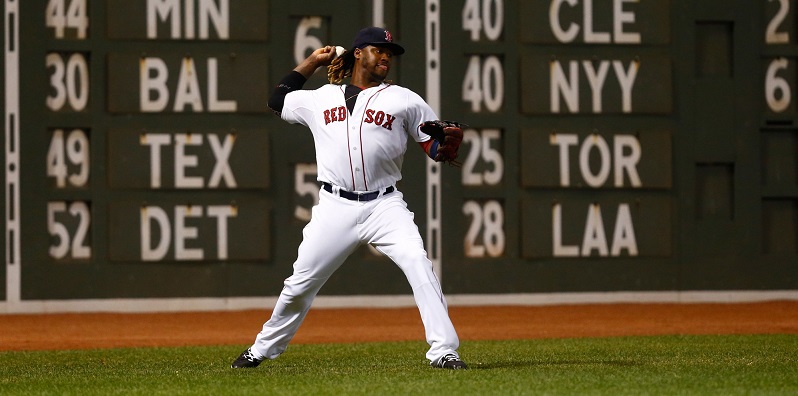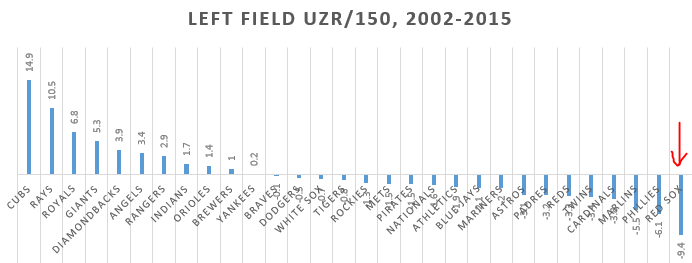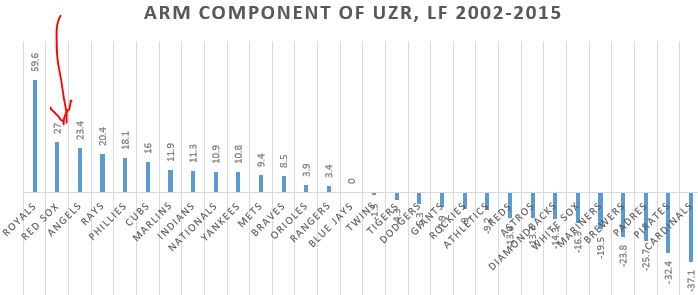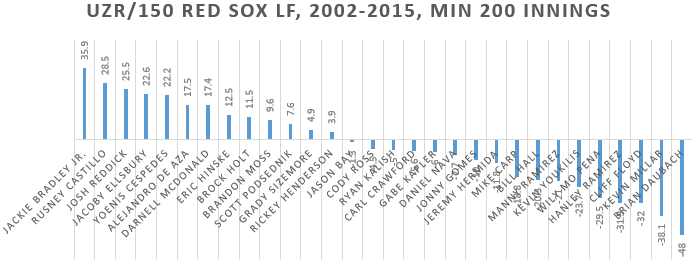It wasn’t good. Hanley Ramirez had learned a new position on the fly before, taking six years of below-average but tolerable work at shortstop and contributing most of a season’s worth of not-quite-as-below average work at third base back in 2012. But Ramirez was by many accounts the worst defender in all of baseball last year, grading out at -19 DRS and -17.8 UZR in just over a half season’s work, good for a -31.9 UZR/150. The other current or former third basemen to give him a run for his money (Pedro Alvarez, Conor Gillaspie, Pablo Sandoval, Cody Asche) really didn’t come close, with Alvarez’s -26.4 UZR/150 at first base almost as amazing, and yet several runs short. When Ramirez was signed as a sight-unseen left fielder, the Red Sox may have figured it wouldn’t be good, but they can’t have thought it would be that bad.
Maybe it wasn’t.
I’m not saying he was secretly good out there—that would be one hell of a secret. And I’m not saying it’s up in the air, because 747.2 innings is such a small sample—it is, but not so small that defensive metrics this extreme aren’t meaningful. What I am saying is that even after adjustments, defensive metrics may have been unfair to Red Sox left fielders, making a very bad season look so bad that it’s hard to believe.
Take out both Ramirezes, and Red Sox left fielders have a -7.3 UZR/150 that would still rank dead last in all of baseball over the last 14 years.
Maybe we need to leave this at the feet of a different Ramirez, to some extent: Manny Ramirez was installed in left field when advanced defensive statistics were first publicly reported, and in 6,478.2 career innings in left for the Red Sox, he managed a -21.0 UZR/150 and looked like a bad fielder. Manny’s stats passed the smell test. And for every other left fielder to have logged 1,000 or more innings in left for the Red Sox, there seemed to be some other way to explain the negative defensive statistics away. Jason Bay and Jonny Gomes were never that great defensively anyway. Carl Crawford was getting older, and had trouble adjusting. Daniel Nava got bounced around too much.
But maybe it’s more than that. Take out both Ramirezes, and Red Sox left fielders have a -7.3 UZR/150 that would still rank dead last in all of baseball over the last 14 years.* Has the team been more comfortable putting bad fielders there than other teams? Maybe. But with all due respect to the ghost of Brian Daubach’s career, it seems unlikely that after taking out two of the team’s worst fielders, the remaining left fielders were still worse than everyone else.
*Note: I got this number after applying some high school algebra to numbers that were already rounded, so it may not be exact—but there’s a lot of room between -7.3 UZR/150 over 13,052.2 innings and the -6.1 UZR/150 Phillies.
Just like Defensive Runs Saved, Ultimate Zone Rating is mostly a function of its range component, RngR. Among the other components, the effect of an outfielder’s arm (ARM) and the effect of boneheaded or inspired plays (ErrR) are next-most important. You should care, because in RngR, the chasm between the Red Sox and the next-worst team is mind numbing: -157.9 RngR to the Phillies’ -112.4 RngR. And just as Fenway taketh away, it also giveth. The Red Sox rank a little differently in ARM than they do in UZR/150 overall, as I’ve once again shown elegantly with a red arrow drawn on a touchpad:
Caveat time: I’m not able to find home/road splits for UZR (or DRS), so if what we’re getting after here really is about Fenway, the effect might be twice the size of what it looks like. Also, how UZR treated left at Fenway was tweaked when the park factors used were made more sophisticated before the 2010 season. It’s probably no accident that among the left fielders with at least 200 innings for the Red Sox, many of the positive marks came from the last few seasons: Jackie Bradley Jr., Rusney Castillo, Yoenis Cespedes, Alejandro De Aza and Brock Holt. Some of this information is still useful, though, for estimating the size of the grain of salt we should take with Hanley Ramirez’s stats last year.
This graph doesn’t tell you how many innings each of these left fielders actually had (see for yourself, if you like), but you get the picture. Some usual suspects, but a few surprises, as well.
Hanley rated worse than Manny did over his career in left, but the -31.9 UZR/150 was hardly unprecedented: Manny’s -33.8 UZR/150 in 2006 was worse. The main difference between them was the extent to which they affected the game with their throwing arms. We don’t have UZR for Manny’s first season in 2001, but in 2002, he didn’t do so hot in ARM: -4.1, almost as bad as Yoenis Cespedes was good in his limited time. After 2002, though, Manny put up a 13.5 ARM, putting a serious dent in his shortcomings with range.
Manny didn’t do dramatically better in left for the Dodgers than he did for the Red Sox, but he did do better, and that was despite seeing his ARM marks go negative once he got there. Looking only at RngR, Manny got worse as he got older: -2.5 ARM in 2002, when he was still DHing, then -9.6, -13.0, and a whopping -30.1 in 2005 when he set his career-high for innings. In Manny’s No Good, Terrible, Very Bad Year in 2006 his RngR was -27.7 (which was actually worse, given a 200 inning drop), and the -13.8 he ended up with in 2007 could have been a real improvement, luck, or both. In the year he split with the Dodgers, though, he improved to -9.5, about where he was in his first full UZR year in left in 2002 in a handful fewer innings. His -4.6 RngR in 2009 is astonishing, even if it was in just 812 innings—and his -3.2 in 2010 in 359.2 innings is almost as surprising. Basically, Manny left Fenway, and then his range was only about one third as bad as it was with the Red Sox. In 2009, the man turned 37 years old.
Manny left Fenway, and then his range was only about one third as bad as it was with the Red Sox. In 2009, the man turned 37 years old.
But wait—there’s more. Carl Crawford was a great left fielder for Tampa Bay; for all of his full seasons, he had a RngR of between 11.7 and 16.5, except for one season. Preceding his Red Sox tenur, Crawford had that 16.5 RngR and then a 14.9 … and then seemed to flush himself down the toilet with a -1.5 RngR in his only full season with Boston (his partial 2012 was also essentially a zero). Back playing left for the Dodgers in 2013, he had a 9.1 RngR in a not-quite-full season’s worth of playing time, essentially picking right back up where he left off for the Rays.
Not sold yet? Then take the left fielder with the second-most innings out there in the UZR era. Daniel Nava’s -7.7 UZR/150 in left was nothing to write home about either way and his 1,702.2 innings were about a thousand short of the sample size we generally consider meaningful. Still, Nava buoyed that number with a 5.1 ARM, and his -14.4 RngR was… not good. But Nava didn’t just play left—he also played 1117 innings of right field, where he had a positive 4.5 RngR and 9.9 UZR/150. Better than J.D. Drew in right, and yet almost as far below average in left as he was above average in right.
A big part of the Green Monster tradeoff is the ability to help control baserunners, but it’s possible that learning to throw from Fenway’s left field requires some kind of adjustment (especially if one is learning the outfield for the first time). Even in the context of Red Sox left fielders, Hanley Ramirez’s -10.5 RngR in just over a half-season of work was flat-out bad. His ridiculously awful -7.3 ARM in the same span is what made his UZR/150 that next level of awfulness, though, and the similar marks for DRS told a similar story (-10 rPM, -5 rARM). It’s possible that learning to throw from the outfield was especially challenging for Ramirez, but ARM is mostly inferential—it is affected by what baserunners try as much as what they try unsuccessfully. A few well-publicized gaffes in the outfield early in the season very well could encouraged runners to try to take extra bases much more often, and then the problem may have snowballed, with the “right” throwing decisions changed for Ramirez.
Balls that hit the wall and aren’t catchable by BIS’s estimation aren’t included in UZR’s RngR calculations. So what gives? I don’t have an explanation, and as I’m not half as smart as Mitchel Lichtman, I wouldn’t deign to suggest there’s an obvious problem in the metrics. It does seem like something is here, though, and it might be as simple as what happens to Coors Field hitters, with home/road adjustments making for a harder row to hoe overall. For now, though, I feel like we don’t necessarily need to heap so much abuse on our man Hanley. And it may be wise to temper our defensive stats expectations for Rusney Castillo and Chris Young this year as well.
Photo by Mark L. Baer/USA Today Sports Images




Very convincingly done. Nice work!
Nice investigation, enjoyed this.
This article was mentioned on Chicago sports talk station 670 The Score. Click this link and start listening to Hour 3 at the 25:25 mark. The person discussing the post (Dan Bernstein) clearly liked what he read.
Boers & Bernstein on 670 The Score – Hour 3 – 03/08/2016 http://cbsloc.al/1RQrL8y
If solely one of the two organizations iss initiatying the plan thesn prssently
the method to communicate when the opposite has initiated their plan must
be determined.